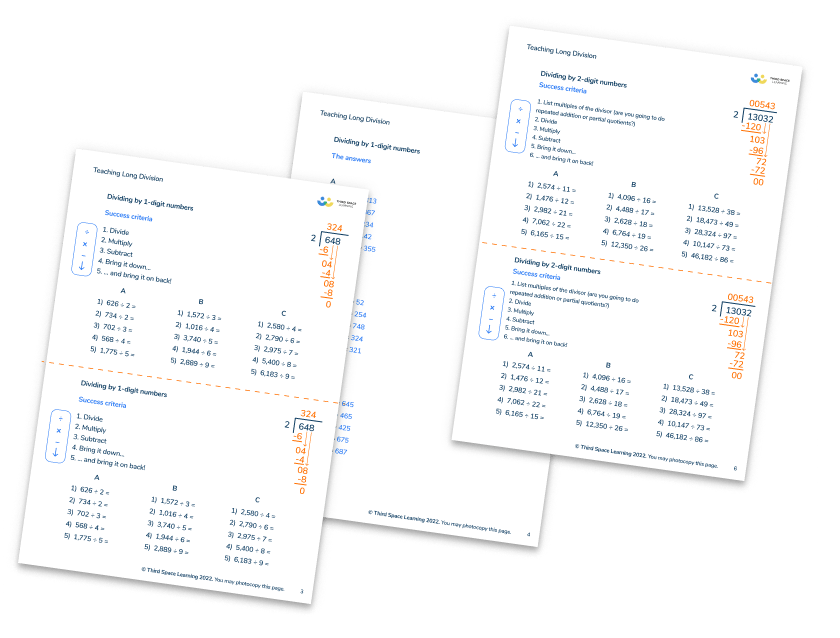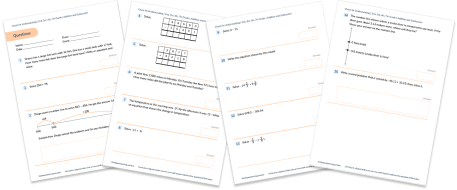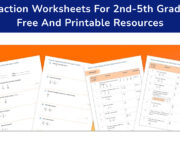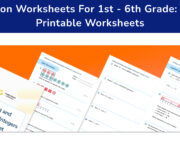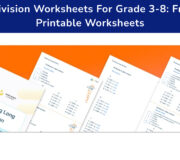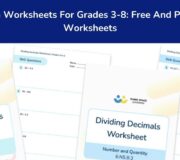Addition And Subtraction Worksheets For Grade 1-8: Free And Printable Worksheets
Addition and subtraction worksheets offer students opportunities for extra practice to strengthen understanding and to build fluency. In this blog, we’ve brought together our best addition and subtraction worksheets and resources to support learning in classrooms from grade 1 to grade 8.
Addition and subtraction are taught alongside one another because they are inverse operations. Addition is one of the first mathematical operations that children learn. Children learn to join quantities together. Then, students learn that a quantity can be taken away or subtracted from another number. These two operations are connected. Teachers use visual models such as ten frames and number lines to help students build conceptual understanding. Fact families also support learners in understanding the relationship between addition and subtraction.
Addition and Subtraction Check for Understanding
Use this quiz to check your grade 2, 3, 4 and 7 students’ understanding of addition and subtraction.
Download Free Now!Why we’ve brought together these addition and subtraction worksheets
Third Space Learning is dedicated to making math resources available to all students. As a team, we focus on helping close the math achievement gap. We work with thousands of educators providing them with math resources, worksheets and teaching resources catered to the needs of their students. We also provide affordable, high quality online tutoring delivered by Skye, the AI math tutor.
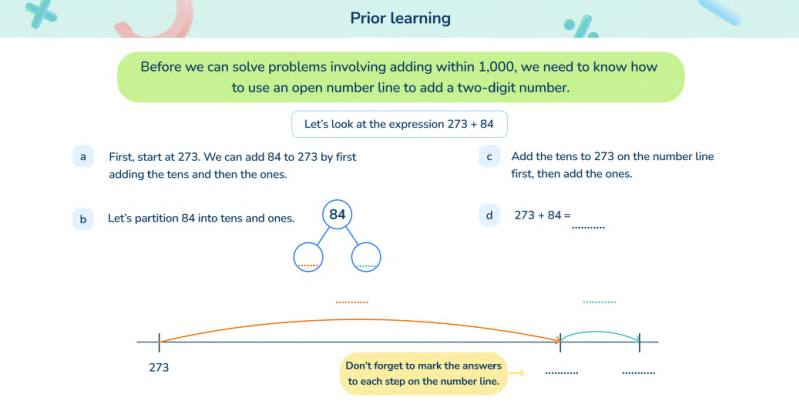
As a team of educators, we listen to the needs of teachers! Creating quality math worksheets designed to meet the learning needs of your students takes time. This curation of addition and subtraction worksheets was created to provide teachers with resources targeted to each grade to help boost student understanding through mixed practice in addition and subtraction.
What to expect from these addition and subtraction worksheets
Every worksheet in this collection was designed by a math expert. These addition and subtraction worksheets are aligned to the Common Core State Standards. These worksheets can be adapted to state-specific standards as well.
Each printable worksheet in the collection includes an answer key. These worksheets are designed to give students the necessary addition and subtraction practice to help them master the skills needed to be proficient in addition and subtraction at their grade level.
How to use these addition and subtraction worksheets
These printable addition and subtraction worksheets make planning for math practice simple! To access them, just click on the corresponding worksheet link, enter your email address and the worksheet and answers will be sent directly to your email inbox, ready to print.
These addition and subtraction worksheets can be used in the classroom or at home for engaging addition and subtraction practice. In the classroom, teachers can use these worksheets for:
For independent practice time students can complete these worksheets individually.
Teachers can use these worksheets as an informal assessment and can use student work to guide lesson plans for small group instruction.
To facilitate mathematical discourse, students can take turns solving the problems on these worksheets with a partner and then explaining their solution strategy to their partner.
For a fun and engaging game, teachers can use the problems in these worksheets for a gallery walk. Teachers can cut out the problems and tape them around the room. Students can walk around with sticky notes and post their solution strategy on the wall for each problem. They can also play ‘sum or difference hunt’ with the problems from these worksheets. A teacher can give the students a number and then have students walk around looking for the problem that results in that number as the sum or difference.
These worksheets can also be used for homework or in homeschool settings to provide addition and subtraction practice. Every addition and subtraction worksheet includes practice problems to help children solidify their understanding of addition and subtraction and develop fluency in their math facts.

Meet Skye, the voice-based AI tutor making math success possible for every student.
Built by teachers and math experts, Skye uses the same pedagogy, curriculum and lesson structure as our traditional tutoring.
But, with more flexibility and a low cost, schools can scale online math tutoring to support every student who needs it.
Find out moreAddition and subtraction worksheets by grade
Below you will find samples of mixed addition and subtraction questions for each grade level, grades 1-8. For each grade level, there is also an explanation of the addition and subtraction skills required and a list of addition and subtraction worksheets to help students to build these skills.
Addition and subtraction worksheets for grade 1
In first grade, learners have a foundational understanding of addition and subtraction from Kindergarten. In the first grade, students build on this and solidify their understanding of the connection between addition and subtraction by adding and subtracting numbers within 20. They also develop fluency and mental math skills with basic addition and subtraction within 10. Students will also begin to add within 100, laying the foundations for place value understanding. In first grade, addition within 100 is more of a focus than subtraction, and they are only expected to find differences in multiples of 10 from two-digit numbers within 100.
Teachers can support 1st grade addition and subtraction skills by encouraging the use of hands-on tools such as counters, rekenreks and base ten blocks, as well as visual models such as ten frames, double ten frames and number bonds. A number line and a 100 chart are also helpful visual tools. Also, following a progression from concrete models to visual and symbolic strategies, also known as the concrete representational abstract progression, can help children build conceptual understanding.
Worked Examples
Example 1
Question: 3 + 6= ___
Answer: 9
To solve this problem, students could use the commutative property to switch the order of the addends so the larger addend is first. Then they could add on 3 from 6. They can do this by counting aloud “6, 7, 8, 9” or by using a ten frame.
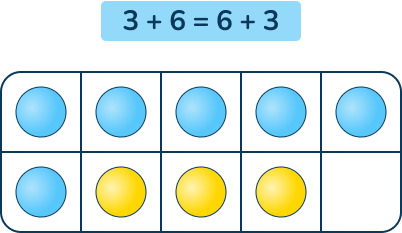
Example 2
Question: 12 + ___ = 20
Answer: 8
This type of problem is known as a ‘missing addend problem’. To solve this problem, learners would need to use a subtraction strategy to find the difference between 12 and 20. Using a double ten frame helps students visualize the difference.
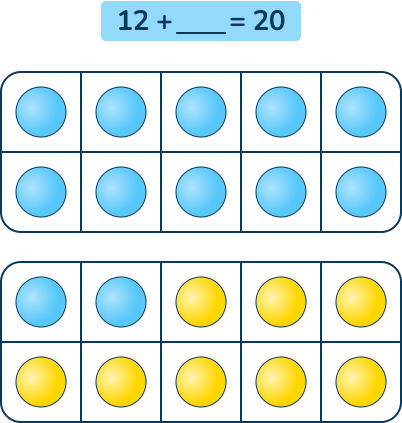
Practice question
Question: There were some friends on the playground. 8 more friends joined. Now, there are 14 friends on the playground. How many friends were on the playground to start?
Answer: 6 friends
Addition and subtraction worksheets for grade 2
2nd grade addition and subtraction is a big shift from 1st grade because it includes addition and subtraction with numbers up to 1,000. Second graders learn to complete addition and subtraction operations involving 2-digit and 3-digit numbers. Second graders use visual models such as base ten blocks and place value models to continue to build conceptual understanding. They are also expected to develop fluency in adding and subtracting numbers within 100. Ten frames and double ten frames are less efficient with larger numbers, so 2nd graders primarily use base ten blocks, 100s charts and other symbolic strategies for addition.
2nd graders are also introduced to the concept of ‘regrouping’ or ‘renaming’ ten ones for one ten and ten tens for one hundred. They also learn how this can be used for subtraction as they regroup one hundred for ten tens or one ten for ten ones. This complex concept requires a lot of practice with hands-on models to understand so it is recommended that students use base ten blocks or a quick picture for problem solving prior to moving towards a more symbolic strategy such as place value addition and subtraction. For more information on how to teach subtraction, check out the Third Space Learning guide.
Worked Examples
Example 1
Question: 54 – 48= ___
Answer: 6
To solve this problem, children could use a base ten block model or draw a quick picture. They also could use place value subtraction (the standard algorithm), however, since these two numbers are so close together, a number line to find the difference may be the most efficient strategy.
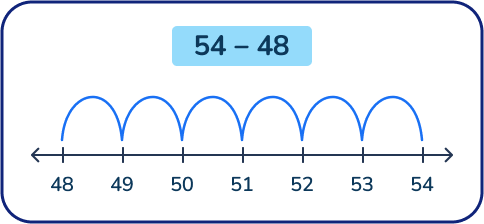
Example 2
Question: 326 + 109= ___
Answer: 435
This problem can be solved in many different ways. Using base ten blocks or a quick picture will help learners build understanding of the sum. Another efficient strategy is to break the second addend into parts and add in parts.
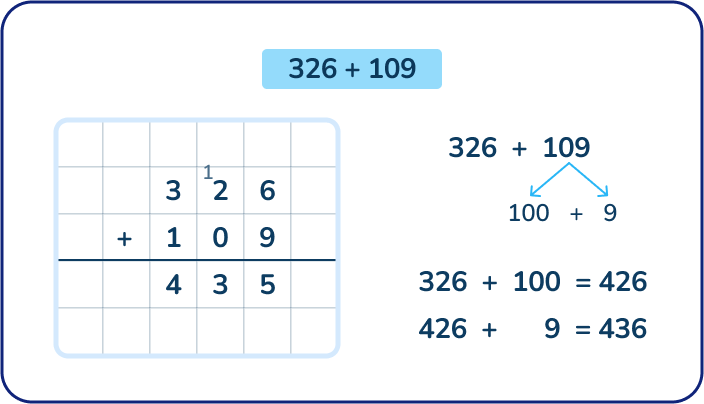
Practice question
Question: 628 people attended the baseball game on Saturday. 432 people attended the baseball game on Sunday. How many more people attended the baseball game on Saturday than on Sunday?
Answer: 196 more people
Addition and subtraction worksheets for grade 3
3rd graders are expected to be fluent in addition and subtraction facts within 20. They also should be able to flexibly and efficiently solve addition and subtraction problems within 100. Addition and subtraction at the 3rd grade level focuses on applying addition and subtraction fluency to adding and subtracting larger numbers within 1,000. Fluency at this level does not mean memorization but rather means that third graders can solve these problems quickly and accurately.
Third graders use a variety of visual models including base ten blocks and place value charts to accurately solve problems with 2-digit and 3-digit numbers. Graph paper is also a helpful tool for organizing addition and subtraction strategies. Third grade is the first time when students learn to use the standard algorithm subtraction and the standard algorithm addition to solve problems, although it is not an expectation until 4th grade. Teachers can support students in using this strategy by helping them line numbers up by place value, by having students check their work using base ten blocks and by reinforcing the meaning of renaming/regrouping ones, tens and hundreds.
Worked Examples
Example 1
Question: 459+___= 600
Answer: 141
This problem can be solved by subtracting 600-459 to find the difference. If you subtract one from the minuend and subtrahend, this problem becomes 599 -458 and then it can be solved more efficiently using the standard algorithm. The difference between 500 and 459 is the same as the difference between 599 and 458, the problem just shifted one on the number line.
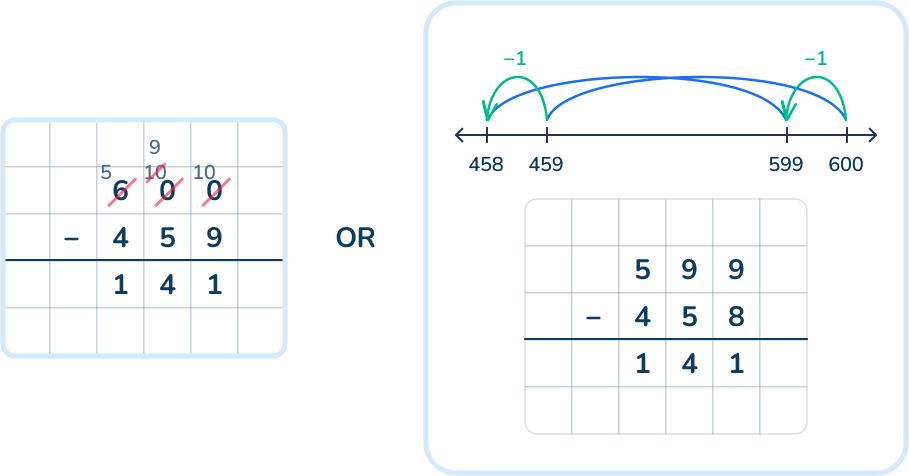
Example 2
Questions: 392 + 599 = ___
Answer: 991
Third graders might solve this problem using the standard algorithm for addition. They will have to rename the ones and tens place since the sum in each column is a two-digit number. They can also solve a similar problem and then compensate. Since 599 is close to 600 which is a friendly number, they could add 392 + 600 and then subtract 1 from their sum. This strategy could be solved mentally because adding a multiple of 10 or 100 is easier to solve mentally than adding a number that is not a multiple of 10 or 100.
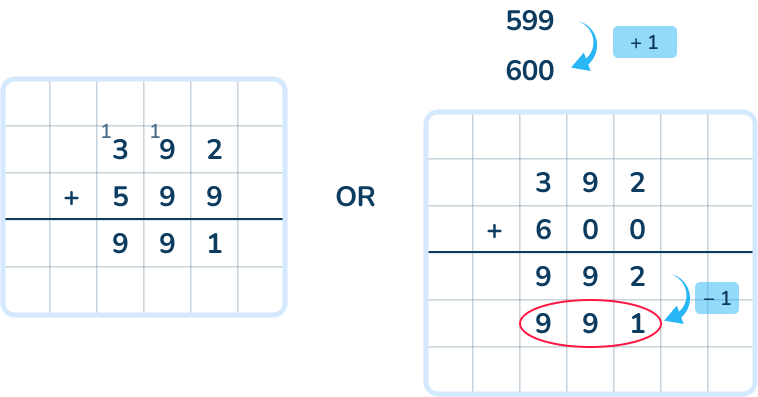
Practice question
Question: There were 346 more apples growing on the farm than potatoes. If there were 218 potatoes growing on the farm, how many total apples and potatoes were growing on the farm?
Answer: 346 + 218 = 564 apples
564 apples + 218 potatoes = 782 total apples and potatoes
Addition and subtraction worksheets for grade 4
Learners in grade 4 are expected to be able to flexibly and accurately use the standard algorithm for addition and subtraction with multi-digit whole numbers (which includes numbers larger than 1,000). They apply this efficient problem-solving strategy to solve single-step and multi-step word problems involving addition and subtraction. 4th grade is also the first time that students learn to add and subtract non-whole numbers, including adding and subtracting fractions and mixed numbers with like denominators. This requires conceptual understanding of both addition and subtraction skills. 4th graders also need to understand the meaning of the numerator and denominator in a fraction.
Teachers can support students in adding and subtracting with fractions by using fraction strips and bar models to solve problems. Also, encouraging learners to check their work using the inverse operation (use addition to check subtraction solutions and vice versa) is a good way to help students check for accuracy.
Worked Examples
Example 1
Question: 3,415 + 429 = ___
Answer: 3,844
To solve using the standard algorithm, the numbers should be lined up by place value and addition begins in the ones place and moves towards the thousands place. A place value chart is a helpful tool to help learners line up numbers by place value.
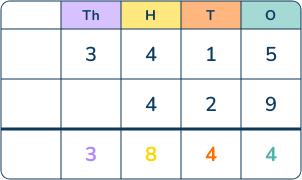
Example 2
Question: \frac{4}{8} - \frac{1}{4}
Answer: \frac{1}{4}
This problem uses two fractions with like denominators, which means one of the denominators can be the common denominator for both fractions. In this case students could solve this as \frac{4}{8} - \frac{1}{4} or as \frac{4}{8} - \frac{2}{8}. Either way, the value is \frac{1}{4} in simplest form. Using visual models to add and subtract fractions at the 4th grade level is important for building conceptual understanding.
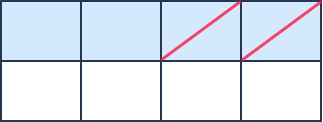
Practice Question
Mary and John each had a \frac{1}{2} pound bag of flour. Mary used \frac{1}{6}of a pound of flour in her cookie recipe and John used \frac{1}{4} of a pound of flour for his brownie recipe. Who has more flour left, Mary or John?
Answer: Mary has more flour left because \frac{1}{2} – \frac{1}{6} = \frac{2}{6} or \frac{1}{3} pound.
John only has \frac{1}{4} of a pound of flour left which is less than \frac{1}{3}.
Addition and subtraction worksheets for grade 5
By fifth grade, students should be fully fluent in adding and subtracting all multi-digit whole numbers. At this level, learners apply their understanding of addition and subtraction to adding and subtracting within the context of a simple expression and they use the order of operations to evaluate each expression.
5th graders also build on their knowledge of adding and subtracting fractions from previous grades to add and subtract fractions with unlike denominators. They also learn to add and subtract decimals to the hundredths. They use a variety of visual models to understand the meaning of adding and subtracting decimals and use strategies based on place value, the properties of operations and the relationship between addition and subtraction to solve decimal addition and subtraction problems
Worked Examples
Example 1
Question: 42.9 – 2.38 = ___
Answer: 40.52
Lining up numbers by place value is an important skill for solving decimal addition and subtraction problems. Putting a place holder 0 in the hundredths place of the minuend is helpful for understanding how to line up the numbers.
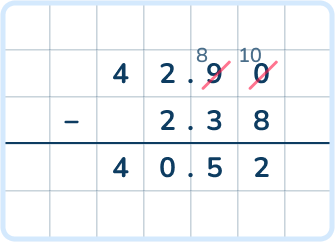
Example 2
Question: \frac{4}{6} + \frac{3}{4}
Answer: 1\frac{5}{12}
This problem uses two fractions with unlike denominators. To solve this problem, learners first must find a common denominator. In this case, the lowest common denominator is 12. Then both numbers must be converted into fractions equivalent to the original addends but using the common denominator. Then the two fractions can be added together and the sum can be simplified.
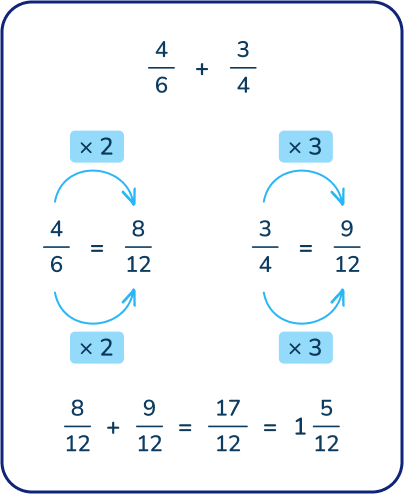
Practice question
Question: At the store, I bought a hat for $9.85 and a pair of pants for $12.99. How much money did I spend at the store?
Answer: $22.84
Addition and subtraction worksheets for grade 6
Sixth grade addition and subtraction is much more complex than elementary addition and subtraction. 6th graders must apply addition and subtraction skills to more in depth real-world and mathematical concepts. Sixth graders should be able to add and subtract multi-digit decimals fluently, using efficient strategies such as the standard algorithm.
6th graders also learn to apply addition and subtraction skills to write and interpret equations with variables representing quantities. They also learn to write mathematical expressions based on real world situations and evaluate these expressions with whole numbers and decimals.
Worked Examples
Example 1
Question: 639.08 + ___ = 913.267
Answer: 274.187
Learners must be precise and accurate in their solution strategy with adding and subtracting large numbers with multi-digit decimals. Using grid or graph paper can help students line up the numbers to solve this problem. Students would need to subtract 913.267 – 639.08 to find the difference between the two numbers (the missing addend).
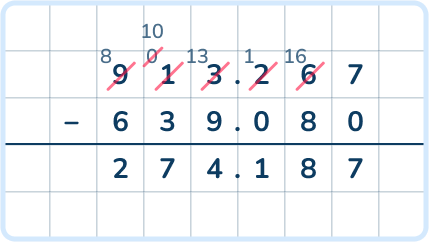
Example 2
Question: Find the value of m in the expression 42.77 + p = m where the value of p is 9.08.
Answer: 51.85
To solve this problem, learners can rewrite the equation using the value 9.08 in place of p to find the value of m. Then they can add 42.77 + 9.08 lining the numbers up by place value to add the two numbers together.
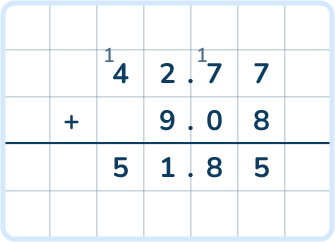
Practice question
I went to a restaurant and bought a soda for $3.75, a burger for $8.89 and fries for $5.50. I had a coupon for $4.99 off the total price. How much did I have to pay for my food? Write an equation and solve.
Answer: $13.15
Possible equation: s + b + f - c = t which represents soda + burger + fries – coupon = total
Addition and subtraction worksheets for grades 7 and 8
In 7th and 8th grade, addition and subtraction are often intertwined with other skills such as understanding positive and negative integers and using scientific notation. At the 7th and 8th grade level, students learn the meaning of rational numbers and both positive and negative integers. They learn that adding a positive integer moves to the right on the number line and adding a negative integer is the same as subtracting that number so it moves left on the number line. They also learn the meaning of a double negative when subtracting a negative number. Number lines and double numbers lines are very helpful tools for 7th and 8th grade problem solving. Learners also apply addition and subtraction to adding and subtracting within linear equations as well as adding numbers with exponents.
Worked Examples
Example 1
17 + (-24) – (-9)
Answer: 2
Students could solve this on a number line, starting at 17, subtract 24 by moving left on the number line. Then subtract the opposite of 9 which means to add 9 and move to the right on the number line.
Example 2
3^2+45−(4 x 5)= xAnswer: x = 34
Start with the exponent:
3^2=9 So, the equation becomes: 9+45−(4 x 5)= xPerform the multiplication:
4 x 5=20 Now the equation looks like: 9+45−20=xAdd and subtract from left to right:
First, add 9+45=54 Now you have: 54−20=xFinish the subtraction: x = 34
Practice question
Question: Sarah is saving money to buy a new phone. She started with $200.
She saves $25 each week from her allowance.
After 5 weeks, she decides to buy some accessories for her phone, which cost $60.
How much money does Sarah have left after buying the accessories?
Answer: $265
Where to find more printable addition and subtraction worksheets and resources
Browse the Third Space Learning resource library for more free addition and subtraction resources. You will find a collection of free printable worksheets, helpful topic guides as well as resources on Numbers and Quantity.
Addition and subtraction highlights
Addition and subtraction are the foundation for many mathematical operations. They are also the first operations that children experience in the real world. Learning to add or join quantities is the foundation for repeated addition and later multiplication. Learning to subtract quantities is the foundation for repeated subtraction and later division. The progression of learning to add and subtract starts with whole numbers up to 10, then 20, then 100 and beyond. Learners begin by using visual models such as ten frames and number lines, and then progress to using base ten blocks and more symbolic strategies. After mastering whole number addition and subtraction, children learn to add and subtract fractions and decimals as well as positive and negative integers. In the upper grades, addition and subtraction skills are applied to a variety of real-world situations.
Do you have students who need extra support in math?
Skye—our AI math tutor built by experienced teachers—provides students with personalized one-on-one, spoken instruction that helps them master concepts, close skill gaps, and gain confidence.
Since 2013, we’ve delivered over 2 million hours of math lessons to more than 170,000 students, guiding them toward higher math achievement.
Discover how our AI math tutoring can boost student success, or see how our math programs can support your school’s goals:
– 3rd grade tutoring
– 4th grade tutoring
– 5th grade tutoring
– 6th grade tutoring
– 7th grade tutoring
– 8th grade tutoring
